"UNCACK is a united effort of the United Nations which provides an outlet for those member nations to provide food, supplies and technical assistance to the Republic of Korea. It also provides an outlet for these nations of the world to furnish help in kind when it is impossible for them to give financial aid."
- Roger E. Bradley
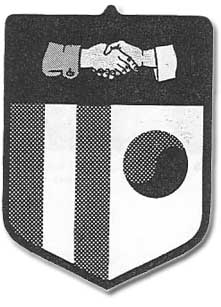
RELEASE NO. 135
WITH THE UNITED NATIONS CIVIL ASSISTANCE COMMAND IN KOREA (UNCACK)
Born under the stress of battle, nurtured under a disrupted economy, and stabilized by its own efforts in building a base upon which it could assist and advise the Republic of Korea - the United Nations Civil Assistance Command in Korea recently celebrated its second anniversary.
UNCACK… is perhaps one of the most unique organizations in the world today. While a military command, it is international in its scope with its personnel originating from 21 countries of the United Nations. Military and civilians are working under army direction in civilian pursuits. Nearly all of its personnel has been selected on the basis of individual specialties. Among its numbers are included doctors, engineers, lawyers, teachers, economists and specialists in all fields of government.
The lessons learned in international cooperation, by this United Nations group, point out that it is possible for foreign groups to plan together and work together if the objective is worthwhile.
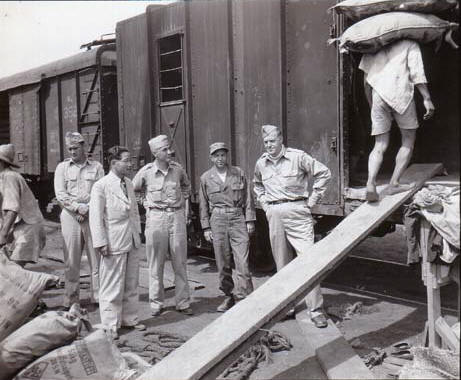
UNCACK is a united effort of the United Nations which provides an outlet for those member nations to provide food, supplies and technical assistance to the Republic of Korea. It also provides an outlet for these nations of the world to furnish help in kind when it is impossible for them to give financial aid. The aid may be in the form of rice from Thailand or sugar from the Philippines. Those who can, give money; others give machinery, food, and other articles to help stabilize the economy of Korea. The main thing is that all give what they can and to the best of their ability as their own economy permits. In the final analysis, who can say who gives most?
UNCACK's problems have been many. When North Korea made its unprovoked attacked on South Korea, the 25th of June 1950, all of South Korea was thrown into panic. A peaceful economy was disrupted, the country's streets WERE filled with fleeing refugees and its industry stopped. Over 4 million people were made homeless by the war and became dependent upon the Republic of Korea for their very existence. Thousands of civilian non-combatants were in need of immediate medical assistance.
Into this breach, stepped the Commander-in-Chief, United Nations Command by sending a select group of 29 officers, 16 enlistee men and 18 civilians from his Public Health and Welfare Section in Tokyo. Their mission…. "to make an immediate survey to determine in what way the United Nations Command could help the Republic of Korea maintain stability in the face of their crisis." In October 1950 this responsibility was transferred to the Eight United States Army. An agency was established and designated the UNITED NATIONS PUBLIC HEALTH AND WELFARE DETACHMENT, with the mission of taking care of this responsibility that had been transferred to the Eighth Army. In December the organization was raised to the status of a major command of Eighth Army and renamed the UNITED NATIONS CIVIL ASSISTANCE COMMAND. In January 1951 its name became the UNITED NATIONS CIVIL ASSISTANCE COMMAND IN KOREA (UNCACK).
The basic mission given UNCACK was: "the prevention of disease, starvation and unrest among the civilian population." This mission was to assure that front line action could go on without interruption by unrest in rear areas. UNCACK later assumed the functions of the Economic Cooperative Administration (ECA) in February 1951, which in turn created an immediate need for specialists in the fields of economics, agriculture, industry, commerce, natural resources, finance, information and education.
From a small organization of 63 persons, UNCACK has grown to a large command of over 700 people. Growth has been nominal, personnel being added only when the demand for specialists developed in new fields.
Central headquarters of UNCACK is established near the seat of the government at Pusan. In the field, operations are conducted by Provincial Teams, one in each province and two teams located on the islands of Koji-do and Cheju-do. Each team has specialists in public, welfare, safety, economics, education, civil information and civil supply. Working in close cooperation and coordination with provincial officials they receive, receipt for and make distribution of food, clothing, and supplies of every type which have been sent to Korea for civilian relief.
One of the greatest contributions made to Korea has been the public health program. When UNCACK started in Korea, more than 240,000 men, women and children had died of disease and deprivation. All of these were war-sufferers, many were refugees. UNCACK went to work on the problem immediately, fully realizing that the war at the front could well be lost if sickness and unrest raged in the rear area.
Medical men have a way of maintaining calmness in the face of insurmountable problems and this problem was no exception. Health, welfare and sanitation closed ranks to present a united front against the ravages of disease. It was a fight against disease unprecedented in world history and the operation began at once.
Army Medical Service, upon call from UNCACK, began to call forward huge amounts of vaccines and other supplies to meet the emergency. Programs for the future were firmed. Teams for immunizing the people were formed and the Republic of Korea entered the program whole-heartedly with their doctors, nurses and personnel.
An orderly attack was made on disease amidst trying conditions and among fleeing refugees. The attack was so orderly in its movement that the people's fears were alleviated and they responded eagerly to what we were trying to do for them. This action on the part of the medical personnel helped stabilize the area immediately behind the front, making it easier for welfare workers to control refugees.
Statistics as such are apt to be boring except when they illustrate a dramatic event in history. As we look at this dramatic fight against disease in the first six months of 1952 we see clearly how well this operation has been. Smallpox was cut 98 percent over a like period of 1951. Typhoid was reduced more than 96 percent and the deaths from this disease were only three percent of what they were last year. Typhus showed a reduction of 77 percent while diphtheria went down 87 percent. Of an estimated 40,000 lepers in South Korea, more than 12,000 were being treated.
Every section of UNCACK can give a thrilling account of their attacks upon major problems, although they may not be as dramatic as Public Health. Welfare Section has stemmed the tide of starvation and unrest by clothing the poor and feeding the millions of war sufferers and by providing homes for the orphaned and the aged. Commerce and Industry Section has put many of the bombed-out industrial plants back into operation by the importation of supplies and machinery parts, thus putting back to work many unemployed. Agriculture Section has imported fertilizer to help bring forth greater crops, thereby increasing the food supply. And so goes the story of rehabilitation of a country at war. UNCACK helps the people to help themselves.
The accomplishment of UNCACK, in close cooperation and coordination with the Republic of Korea, would not have been possible had it not been for the assistance received from many agencies of the United Nations. The United Nations Korea Rehabilitation Agency (UNKRA) has worked hand in hand with UNCACK during the past year. In the coming year UNKRA is planning to spend more than 70 million dollars in permanent rehabilitation projects.
UNKRA has worked with UNCACK by lending to UNCACK 134 of their personnel for work at headquarters level as well as at team level. The successes of UNCACK are jointly shared with UNKRA.
Another agency organized recently is the Combined Economic Board (CEB), which is composed of members from the United Nations Command and the Republic of Korea. Their duty is to allocate the vast amount of relief goods coming into Korea, strictly on the basis of need, to the Korean people. They also decide what relief articles will be brought into Korea for sale purposes.
With agencies in the rear, working in close coordination and cooperation with those at the front, there can be no doubt that we shall have ultimate victory over the communist forces. The United Nations Command, UNCACK and UNKRA and the Combined Economic Board working together are assuring success.
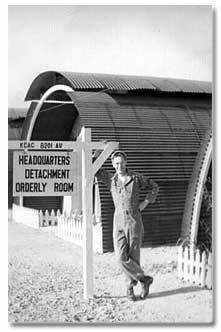
By PFC James De Rose
Special to Pacific Stars & Stripes
From PIO, HQ., KCAC
(Undated news article)
KCAC veteran Roger Bradley of New York submitted the following Stars & Stripes article to The Korean War Educator website.
TODAY IN KOREA, an American nurse is conducting a school for young Korean student nurses, preparing them for future service to their communities and their nation…a Briton on the island of Cheju is physician and adviser to a populace without adequate medical care…a U.S. Army major is demonstrating to Korean farmers better methods of cultivating crops and protecting livestock…a civilian forestry specialist from the U.S. is organizing 4-H clubs among the youth of the Republic of Korea…an economist advises a ROK minister…a home is being built…an industry is growing…an economy is becoming stable. A nation, unnaturally divided, its sap drained by an exhausting war, and only now beginning to realize some of her inherent economic potential, is steadily dressing the wounds of a conflict which all but stripped her naked.
To be sure, the rehabilitation of this country, which was the initial battleground in the struggle between Democracy and atheistic Communism, is the responsibility of the Koreans themselves; nor would they wish it to be other than that. None the less, many agencies of the U.N., both military and civilians, are actively aiding in this regeneration, contributing whatever they are able toward the common goal.
THE INSTANCES CITED ABOVE, however, represent the activities of one agency, one group, one body—the Korea Civil Assistance Command. Seemingly unrelated, save for purpose, these functions and many more are each day planned, coordinated and carried out under the sponsorship of KCAC, whose task it is to aid the people of the Republic of Korea to become self-sufficient and able to carry on their own development.
KCAC, with headquarters in Seoul, is a major military command of the Far East Command, charged with the responsibility for preventing disease, starvation and unrest in the ROK, and assisting in the rehabilitation of a nation which seeks economic stability in an atmosphere of post-war uncertainty.
Headed by Brig. Gen. F.K. Hayden, KCAC succeeds the U.N. Civil Assistance Command, Korea (UNCACK), whose wartime mission was to stabilize rear areas so that frontline military operations could proceed with the minimum of disturbance. In carrying out that mission, UNCACK performed fantastic feats in the field of health and social welfare in the face of seemingly insurmountable obstacles.
To cite an example of this success, UNCACK's efforts in reducing diseases showed these results in 1952: Typhoid was reduced more than 96 percent from what it was at the outset of the war and deaths from this disease were only three percent of what they were the previous year. Typhus showed a reduction of 77 percent and diphtheria went down by 87 percent of what it was in 1951. Of an estimated 40,000 lepers in Korea, more than 12,000 were under treatment in 1952. Much the same story could be told by each of the specialized branches of KCAC operating then.
When reconstruction and rehabilitation in Korea became the major concern of the U.N., it was decided that KCAC be designated a major command and assume the added mission of rehabilitation in the ROK. This it has been doing since July 1953.
ACTUALLY, KCAC is best expressed in terms of its field teams, located throughout the provinces of Korea, whose job it is to furnish "grass roots" civil assistance in their areas. Comprised of an average of 20 persons, half of whom are civilian specialists, the team implements programs initiated at KCAC Headquarters.
Civil assistance team functions may be seen in the distribution of relief goods to end users, in furnishing technical advice to provincial, local and civic bodies, in maintaining sound health standards, by education—in any of a thousand ways—each designed to assist the Koreans in their task of reconstruction.
The teams' members originate from many countries and many walks of life. Military administrators, supply specialists, public health personnel, doctors, nurses, veterinarians, economists, all lend their particular talents to the smooth functioning of a unit which, in most cases, is the only link between board "relief programs" and the people who benefit from them.
Often the team has been the first source of consolation in time of disaster. During the tragic Pusan blaze, KCAC lent every effort to ease the sufferings of the populace by providing food, blankets and temporary housing. But whether misfortunate strikes a large city, like Pusan or small one like Cheju City on the island of Cheju, the response from KCAC is the same—immediate assistance.
ON A HIGHER LEVEL, in KCAC Headquarters, civil assistance activities are coordinated with many other agencies who seek the economic reconstruction of Korea. Among these are the U.N. Korea Reconstruction Agency and the Office of the UNC Economic Coordinator. Many of KCAC's personnel are active in both these organizations and maintain close liaison with KCAC Headquarters and ROK officials concerned with rehabilitation. Also, many of KCAC's branches are so organized as to be counterparts of ministries in ROK government, advising and assisting them in expediting the many problems of economic recuperation. Every effort is made to prevent duplication of effort on the part of U.N. agencies, and in this regard much success has been achieved.
KCAC also lends support to a host of smaller, independent relief agencies. KCAC has an association with numerous long-range projects aimed at rebuilding the Korean economy. KCAC is providing for power rehabilitation programs, for farm resettlement, for the renovation of Korean transportation and communications systems, and for the social welfare of the population in general.
A comparatively small organization, boasting only some 6000 U.S.-U.N. personnel, KCAC quietly pursues its dedicated aim of restoring Korea to the economic and social dignity to which it has every right, by "helping Koreans help themselves." For, like the forces of the U.N. themselves, KCAC was born of a struggle that has never ended.
KCAC veteran Roger Bradley of Valatie, NY took these pictures of the New Rochelle Victory during a welcome ceremony for the ship and the relief goods it carried. The occasion was significant enough to attract a Navy band, South Korea's President Syngman Rhee, and U.S. Senator Knowlton. Below left: Rhee expressing his appreciation for newly-arrived relief goods. KCAC distributed the goods. Below right: US Senator Knowlton presenting the relief goods to the people of South Korea.
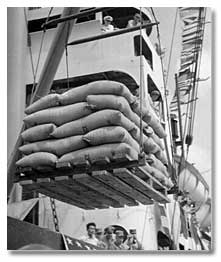
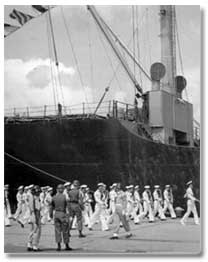
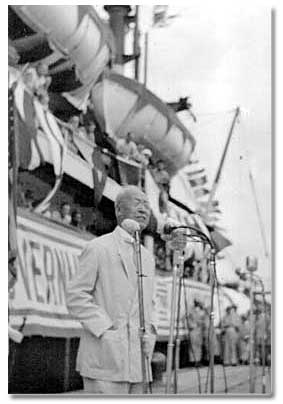
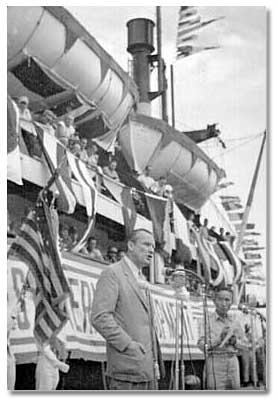
On April 6, 1954, President Syngman Rhee of the Republic of Korea presented the Korea Civil Assistance Command the Presidential Unit Citation for distinguished humanitarian services and achievements in the prevention of disease, starvation and unrest among the civilian population of Korea during the period December 10, 1950 to September 30, 1953.
The citation reads in part: "… By importing food, clothing, medical aid goods, and large quantities of fertilizer to increase crop production the tide of suffering of over 4,000,000 people has been stemmed…Working effectively with Korean medical personnel KCAC has been highly successful in reducing the disease rate. In addition, the Command has aided in the support of over 90 hospitals, 500 medical aid stations and 355 orphanages, has provided refugee camps and has established and operated more than 60 feeding stations which furnished meals to approximately 55,000 persons daily."
The Korea Civil Assistance Command (KCAC) was created a major command of the Far East Command on 1 July 1953, as a successor to the United Nations Civil Assistance Command (UNCACK).
Having personnel originating from 21 countries of the free world and specialists in nearly a dozen fields, KCAC retains the same responsibilities of UNCACK—"the prevention of starvation, disease and unrest"—with the added function of "rehabilitation." It has grown from a war time, emergency effort to an organization dedicated to the relief and restoration of the Koreans—by helping Koreans help themselves.
Basically, KCAC is a military unit of the US Army. It is, moreover, a United Nations effort, providing an outlet for member nations to provide food, supplies and technical assistance to the Republic of Korea.
Initially, civil assistance took the form of a complement of 29 officers, 16 enlisted men and 18 civilians, organized as an emergency measure by the Commander-in-chief, UNC, "to make an immediate survey to determine in what way the UNC could help the ROK to maintain stability in the face of their crisis."
Later, in October 1950, an agency was created under the Army and designated the US Public Health and Welfare Detachment. In December, it was renamed the UN Civil Assistance Command, subsequently assuming its full name of UN Civil Assistance Command, Korea (UNCACK).
The mission of UNCACK was to assume that front line action could carry on uninterrupted by unrest in the rear areas. Headquarters was established near the seat of the ROK government in Pusan. In the field, operations were conducted by provincial teams: one in each province and one each on the islands of Cheju-do and Koje-do. (Since that time the Koje-do team has been dropped and a special team added for the city of Seoul.) Each team was so organized as to include specialists in the fields of public health, welfare, safety, economics, education, civil information and civil supply. Working in close cooperation with provincial officials, they received and made distribution of all types of relief goods.
From a small organization of 63 persons, UNCACK grew to a large command of over 700. Of great importance was the contribution made by the Public Health section. Faced with the fact that more than 240,000 men, women and children had lost their lives due to disease and deprivation, medical men went to work, and through UNCACK, began to call forward huge supplies of vaccines and other emergency supplies to meet the need. Typhoid was reduced more than 96 percent and deaths from this disease fell 97 percent in a period of a year. Typhus showed a reduction of 77 percent and diphtheria went down 87 percent in a year. Of an estimated 40,000 lepers in Korea, more than 12,000 are now under treatment.
But the accomplishments of UNCACK and KCAC would not have been possible had it not received the cooperation it did from many other agencies of the United Nations. The United Nations Korea Reconstruction Agency (UNKRA) has worked hand in hand with UNCACK and KCAC throughout their years in Korea.
The functions of the field teams of the Korea Civil Assistance Command are best expressed in terms of the functions of KCAC itself; for the teams are the operating and implementing arm of the command and the backbone of the civil assistance program. What KCAC is to the national government of Korea, so too is the field team to the provincial governments, and the success of the entire rehabilitation effort depends in no small measure upon the smooth functioning of the KCAC field teams.
Retaining some identity in internal make-up with the headquarters KCAC, the field teams utilize both military and civilian personnel to carry out their mission, and maintain advisory personnel to coordinate assistance projects with local officials. Although the size of each team may differ with locale, the typical team averages slightly over 20 persons plus Korean personnel. Each team has approximately five officers with the remainder evenly divided among civilian technicians and enlisted men.
With sections dealing in public health, welfare, housing, sanitation, and agriculture, specialists are utilized to assist the speedy and efficient expedition of the civil assistance program as it affects the individual province. In addition to giving on-the-spot relief to any area stricken by disaster, the teams offer a "grass roots" example of what cooperation can mean to the Korean people in their struggle to build a stable economy.
The primary mission of KCAC's Agriculture Branch is to rehabilitate and increase the agricultural and forestry production of South Korea. More than 70 percent of the population derives the major portion of their incomes from this source. Therefore, it is essential that programs directed toward the rehabilitation of South Korea's agricultural and forestry activities should receive prime consideration.
Production of sufficient food to maintain the ever-increasing population has become a greater problem each year. Erosion, caused as a result of the destruction of forests to produce fuel for cooking, heating and lumber for construction, has greatly decreased the amount of arable land in South Korea.
As the population increases, agricultural programs must aid to (1) increase production by all available means, (2) reclaim all previously unproductive land capable of producing food, (3) prevent further erosion, (4) prevent destruction and loss from plant diseases, insects, and other pests, (5) increase livestock and (6) prevent infectious diseases.
Programs for Korean agricultural rehabilitation have become the responsibility of United Nations organizations since the Korean economy is at such a low ebb. The ROK neither has the money nor the technical knowledge to undertake projects of this nature. It is hoped the Koreans will absorb the more advanced agricultural methods introduced by the UN agencies and will strive for maximum production from their land in the future.
The basic mission of the Communications Branch is to assist the ROK in rehabilitating its communication system. Combating problems created by wartime devastation and lack of technically trained Korean personnel, this branch is endeavoring to help lay the groundwork for more ambitious programs to come.
In addition to offering technical advice, this branch is aiding in planning the expenditures of FOA funds allocated to reconstruct the communications system in Korea. Under the FOA program for FY 54, $4.7 million has been programmed to provide the following communications facilities: (1) 20,000 lines of automatic telephone equipment for the city of Seoul, (2) a school to train communications specialists, (3) 3,000 line manual switchboard and distribution plant for Taejon, (4) l,000 line manual switchboard and distribution plant for Masan, (5) a distribution cable plant in Seoul, (6) equipment and vehicles for maintenance of telephone plant, (7) radio equipment for the domestic radio-telegraph system.
Future funds will be used for the restoration of other communication facilities, particularly toll centers and trunk circuits to link the communities together.
This branch will continue to base its operations upon the local requirements, economic status of the country and technical ability of the Koreans in an endeavor to restore the maximum amount of communications possible with the FOA funds made available for that purpose.
The basic mission of the Power Branch is the restoration of present power plants and transmission systems that have been damaged by combat action, lack of maintenance and age. The secondary mission, and increasingly more important, is the new development of necessary and adequate generating plants and transmission and distributing facilities to meet the needs of an expanded industry in the ROK.
The present power system is part of a system formerly extending to the Yalu River and was not designed for the isolated type of operation now existing. There are many deficiencies in the system resulting from this isolated operation, together with damages caused by war and depreciation.
For the past several years, about one-third of the power used in South Korea has been produced by US owned and operated barges located at Pusan and Masan, and costing the US taxpayer about $3,000,000 per year. A plan for future production has been prepared in conference with combined planning groups of FOA, UNKRA, KCAC and ROK, which will increase the present maximum generating capacity from 238,000 KW to 480,000 KW and provide 300,000 KW of dependable power as compared to an estimated minimum demand of 225,000 KW by 1960.
This plan includes further rehabilitation of existing power and transmission facilities. In addition, three new thermal and three new hydro plants are planned. Two of these latter are FOA projects and one is by the ROK.
The Public Works Branch has the mission of advising and assisting its counterpart in the Republic of Korea Government, other branches of KCAC Headquarters, when requested, on matters requiring technical guidance to promote and improve the efficiency in the field of public works.
Personnel of this branch work in close cooperation with Korean officials of various ministries on the design and preparation of plans and estimates of materials and labor necessary for the construction of hospitals, orphanages and other welfare institutions, waterworks and sanitation projects, highways and bridges, government buildings, city planning, and grain warehouses.
Since September 1951, when the first allocation of CRIK materials was made, there has been over 100,000,000 board feet of lumber allocated for various projects. Nails, roofing paper, cement and glass constitute the other major demands.
In the FOA program for 1954, $11 million has been set aside for public works. The major portion of these funds will be used to rehabilitate water plants and other public utilities, streets, roads and bridges, government buildings, and grain warehouses.
One of the problems facing South Korea is the definite shortage of graduate Korean engineers who possess the knowledge and experience required for this tremendous rebuilding task. Therefore, the necessity of the Public Works Branch, consisting of engineers who are experts in various fields, can readily be visualized.
The basic mission of the Public Health Branch is to prevent disease and unrest. Under KCAC supervision, acute communicable diseases have been reduced from epidemics to small local outbreaks, water systems have been made operational, professional and health education have been initiated, stimulated and expanded, and the chronic diseases have begun to receive major attention.
The branch is divided into five sections—Preventive Medicine, Medical Care, Nursing Affairs, Environmental Sanitation and Medical Supply.
Under the Preventive Medicine Section come the mass immunization programs aimed at reducing and preventing disease. These programs proved exceptionally successful in reducing the number of cases and the death rate from disease.
The Medical Care Section is concerned with improving medical institutions and raising the caliber of professional personnel operating these institutions.
Nursing Affairs Section renders consultant and advisory services to the national and provincial governments in addition to operational duties within the KCAC public health programs.
The Sanitation Section primarily assists and advises the ROK Ministry of Health on coordinated sanitation programs.
The Medical Supply Section is organized to advise and assist on matters pertaining to programming of medical and sanitation supplies for Korea.
The Social Affairs Branch is responsible for the relief and welfare aspects of the KCAC mission in Korea, part of which is the prevention of disease, starvation and unrest among the civilian population. The broad Social Affairs mission is to insure minimum relief to needy refugees, war sufferers and other indigent persons in the ROK; to promote return of refugees and other indigent persons to a productive status in the Korean economy; to assist the ROK in development and administration of public welfare programs and services suitable to the overall economy of the nation.
Basic policies governing the UNC relief and welfare programs dictate that all UN relief goods must be pooled for distribution against general relief needs; economically and effectively used to prevent starvation, disease and unrest; allocated on the basis of greatest need; and distributed through ROK channels in accordance with procedures jointly agreed to by KCAC and responsible ROK authorities and approved by the Combined Economic Board.
Voluntary relief agencies with established missions in Korea are authorized and encouraged to operate their programs and to import relief supplies in their direct support. The Branch furnishes technical advice and guidance to the ROK Ministry of Social Affairs on programs for needy refugees, war sufferers, and other categories of destitute persons; on programs to reduce the number of persons dependent upon relief; and helps develop effective plans for allocation and distribution of relief goods.
The primary mission of the Supply Division is to supervise the receipt, handling and accounting for all Civilian Aid Supplies shipped into Korea, regardless of whether they are furnished by member nations of the United Nations or by private relief organizations in the United States and other countries.
Basically, the Supply Division is divided into four branches; Civil Supply, Movements Control, Sales and Records.
The Civil Supply Branch acquires and develops information necessary for the proper handling and control of relief supplies. This branch maintains records of approved supply programs and forecasts, and schedules the arrival into port facilities of all supplies for Korea. A schedule of distribution throughout Korea is developed in conjunction with the forecasting and shipping.
Movements Control Branch prepares the movement plan for receipt, port clearance, transportation and "in transit" storage of supplies for which KCAC has responsibility. The major supply items received are grain, coal, POL, fertilizer, lumber and cement.
Sales Branch supervises the sale of CRIK materials and Army surplus and salvage items as are turned over to the command for distribution to Korean Employees Sale Stores. These facilities serve Korean employees of UN installations.
The Records Branch compiles and maintains the necessary records and reports to account for receipt of all civilian supplies for Korea.
The mission of the Transportation Branch of KCAC is to rehabilitate and develop the transportation system of the ROK with an eye toward increasing its capacity to expedite goods between the principal points of use. The development of the transportation system under Japanese occupation left a marked deficiency in the lines connecting the eastern and western coasts, and normal connection was available only North and South between the principal cities of ROK.
Since all forms of transportation are inter-dependent, the development of any one form depends in large measure upon the capacity for expansion of the others. In planning for the rehabilitation of the ROK's transportation system the following factors were taken into consideration.
The transportation system of Korea is comprised of the Korean National Railway (KNR) having 1,683 miles of route; 10 major and 57 secondary ports; a merchant marine of 39 vessels, 14 of which are ocean going; a network of 9,540 miles of roads which is not paved save for Seoul and Pusan; a fleet of old trucks and buses; 2,000 small wooden vessels, and streetcar systems in Seoul and Pusan.
Taking all factors into consideration, lack of adequate transportation facilities is the greatest single factor hampering the economic recovery of Korea. The transportation program as drawn up is calculated to enable imports under the expanded aid program to be distributed properly and to promote the internal economy of the country.
[Bradley was a supply--then company clerk--with KCAC in 1953/54.]
"KCAC was originally United Nations Civil Assistance Command (UNCAC) and changed to Korea Civil Assistance Command (KCAC). KCAC was a united effort of the United Nations to provide an outlet for those member nations to provide food, supplies and technical assistance to the Republic of Korea. I was assigned as a supply clerk and later as company clerk of Headquarters Company. We were officially, the 8201st Army Unit assigned to 8th Army.
When I was assigned to KCAC I had no idea what its responsibilities were. I learned after joining the outfit. When North Korea attacked South Korea, all of South Korea was thrown into panic. A peaceful economy was disrupted, the country's streets were filled with fleeing refugees, and its industry stopped. Over four million people were made homeless by the war and became dependent upon the Republic of Korea for their very existence. Thousands were in need of immediate medical assistance.
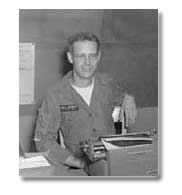
I arrived in Korea in late March 1953. I had a quartermaster MOS and KCAC needed supply people. So, I ended up in headquarters unit supply room when I guess there was a need for a supply clerk. I was not qualified for this position but it was not hard to lean to issue supplies. When the 1st sergeant learned I could type, I was moved to the Headquarters Company Orderly Room and assigned Company Clerk. A supply clerk worked at company level and received and issued those items necessary for a unit to function. These items included items of clothing, soap, mops, buckets, bedding, including the cots, etc. A company clerk worked in the orderly room of a company and was, in effect, the secretary to the 1st sergeant and the company commander.
KCAC had its Headquarters located in Pusan and moved to Seoul in April of 1954. We had teams in each of the provinces and on the island of Cheju-do. Headquarters offices were located in a masonry building that once was a maritime college. This was a large building and looked like many older schools in the United States. It was a two-story building and the classrooms were converted to offices.
KCAC included approximately 700 officers, enlisted men, and civilian personnel. We were tasked to the responsibilities of prevention of starvation, disease and unrest with the added function of rehabilitation dedicated to the relief and restoration of the Koreans by helping Koreans help themselves.
The programs were funded by the 21 countries. These countries assisted with funds and/or goods as their economies allowed. The supplies consisted of food, clothing, medical supplies, building supplies, etc. They were distributed by the teams in the various provinces. Everyone was needy. The member nations supplied personnel to the teams. The personnel consisted of doctors, nurses, and technical people in the fields of agriculture, communications, power, public works, public health, and social affairs. Also, supply, transportation, etc. These were the decision makers.
There was one KCAC team in each province. Each team consisted of about 20 personnel plus Korean personnel. There were nine provinces plus there was a special team in Seoul. The provincial teams were located in the capital of the province. Cheju-do was a province. Our living quarters were quonset huts located on the compound that included the headquarters building. The quonset was shared by about ten or twelve GIs as I recall. Other buildings included a large mess hall, officers club and an EM club. We had a firehouse, maintenance building, an Armed Forces Radio Station building, and probably others, but they do not come to mind.
I don't know too much about the Seoul team. I believe it was established in Seoul to work directly with the national government. The quonsets were heated by kerosene space heaters—two large ones, one on each end. They were like a parlor heater and were flued through the roof. The floor of the hut was wood.
The AFRS maintained a radio station and broadcast news and music. It also picked up ball games etc. It functioned like a stateside radio station.
Our duty hours were like a normal work day. We rose to reveille and had a formation at 0630 hours. Breakfast and then off to work, 8 a.m. to 4 p.m. Entertainment was diversified. We had a hobby shop. The items made in the Hobby Shop were models of all kinds as well as jewelry, leather goods, etc. These items could be taken or sent home. Most sent the items rather than try to carry extra baggage home with them. We had sports, swimming in the bay. We had access to Armed Forces Educational correspondence courses. We had activities at the EM club—games, dances, etc. The games played in the club were board games, cards, shuffle board etc. We danced with Korean girls. The girls were allowed onto the compound for these dances. They came on at 7 p.m. and had to be off the post by 11 p.m. I did not take any R&R. The USO shows were devoted to the units in the front, and rightly so.
We did employ Korean nationals at the company level. They were used for maintenance, laundry, houseboys, etc. I did not make any personal friends; however, we all became attached to our houseboys. These were teenagers who performed housekeeping in the quarters for us. They did light laundry, shoe shining, etc. Our houseboy's name was Kim. Other than the fact that he was a student, I have little info about him. He was a very nice kid, always neat and clean. He was on the compound for employment, paid by ourselves. We had one houseboy per hut. On one trip for a mail pickup, my driver, a Korean national, hit a pedestrian. It caused quite a commotion among the bystanders and we were being threatened. I drew my pistol, got out of the jeep, unloaded the mail bags, and instructed the driver to take the injured man to the hospital. I waited on the sidewalk for him to return. My decision defused the situation and I was able to wait without incident.
On the headquarters level there were many civilians from various countries assigned to the various sections. These people were specialists in the fields we were involved with. We were secure from the fighting, however, we armed ourselves when leaving the compound and we maintained a 24-hour sentinel detail. I never felt any personal danger. We did have to be fully armed when leaving the compound. We had automatic rifles, 45 cal. Pistols as well as shotguns.
I do remember the day the truce was signed. Rumors had prevailed for days. Naturally, there was much relief among us on July 27th. As I recall, we celebrated at the club. After the truce, KCAC personnel continued as before. The work of the teams became more intense as they were now able to move more freely and into more areas of the provinces. Again, this was done with alertness to the danger of hostile forces. My duties did not change significantly except for new responsibilities. Before we moved our HQ to Seoul, the first sergeant went with the advance party to set up the company area. I then assumed the duties of the 1st sergeant. Everything remained the same as before the truce.
A tour of duty in Korea was 16 months, so I knew for a long time as to when I would be leaving. I did not know the exact date. My orders were cut on July 8, 1954. I came home aboard the USS General Randall. It was a larger ship and faster than the Marine Lynx. I had no assignments aboard ship. The mood was a happy one. We were all anxious to get home. I was happy to leave Korea but felt sad to be leaving the friends that I had made. We landed in Seattle. There were very few people welcoming the arrival of the ship. Some of the soldiers had family waiting for them. I do remember this because we were told to remain in ranks and not to jump the barriers. This was ignored by those with family. They were anxious to see those waiting for them.
I think my experience in Korea gave me a better appreciation of the U.S. seeing how the Korean people lived in comparison to our way of life had to make an impression. Did Korea change me? Yes. I left an immature young man and came back with a more mature outlook."